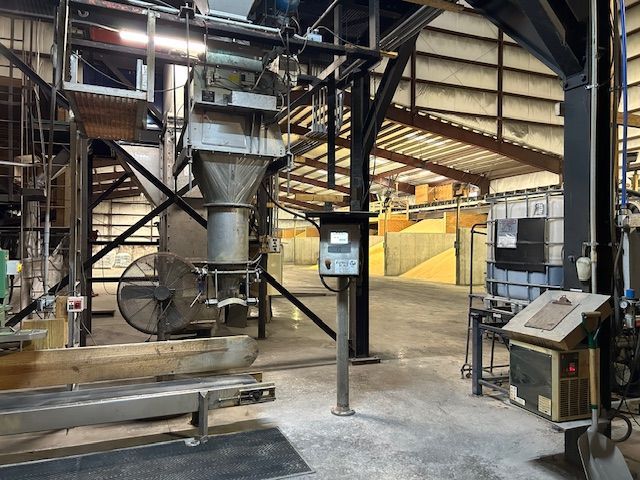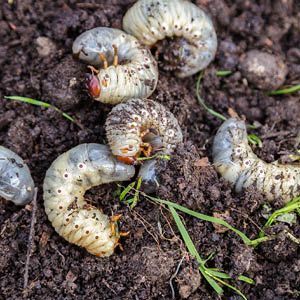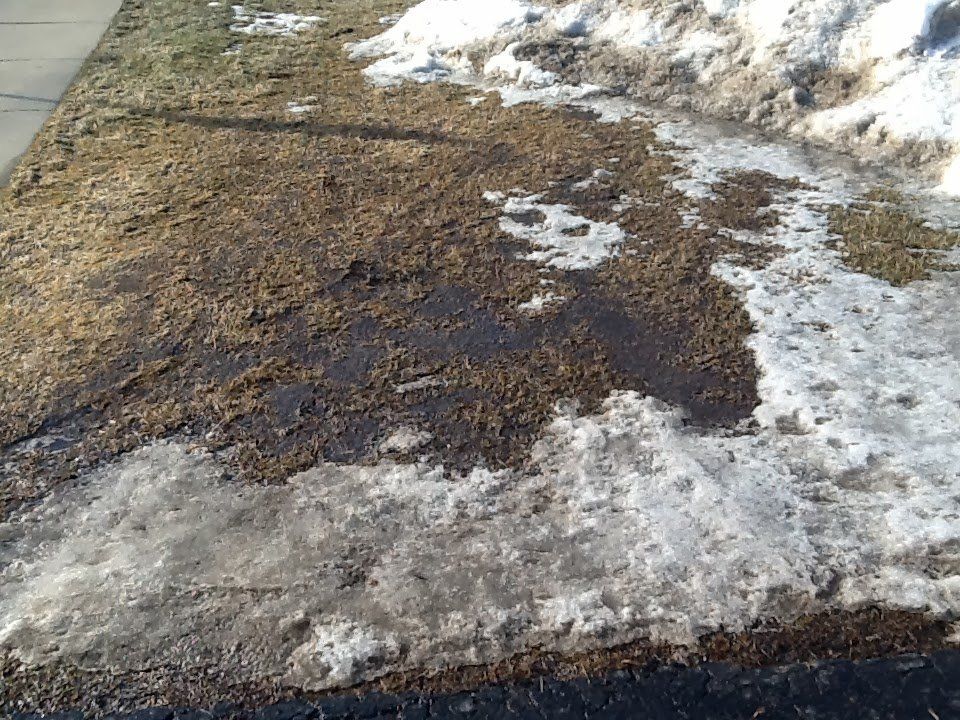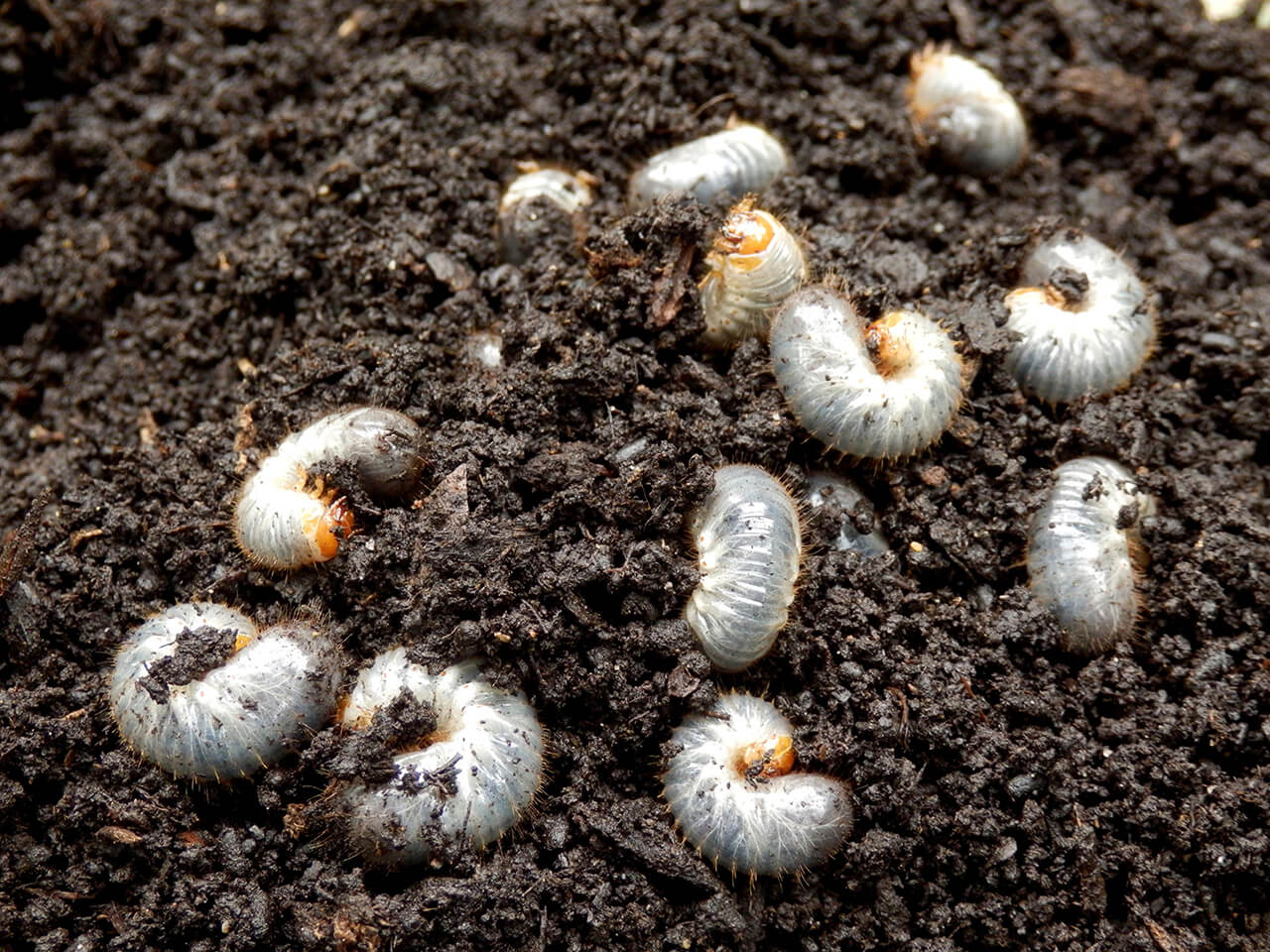LEARN HOW TO RESTORE 5 COMMON TYPES OF LAWN DAMAGE
There’s nothing more frustrating than having a beautiful lawn ruined by a dead spot or divot. From fertilizer spills to mechanical damage, consider this feature your ‘pocket book’ guide to quick lawn repair. No messing around…let’s get your turf back in top shape!
1. FERTILIZER SPILL
It happens. Whether you’re filling up your spreader with a bag of granular fertilizer or filling your spray tank up with liquid, a fertilizer spill (especially those high in nitrogen) usually ends up leaving your turf with a dead patch. When fertilizer spills, nitrogen-containing salts draw water out of the soil as well as plant tissues, leaving turf to desiccate (dry out). Too much nitrogen also shifts the soil pH more acidic which creates a challenging growing environment. The good news is, if you act quickly, you might be able to save your turf from almost certain devastation.
Fig. 1. Fertilizer Spill
In the event of a granular fertilizer spill…
- If practical, and depending on the severity of the spill, sweep the fertilizer granules up as best you can by any means (shovel, broom, vacuum, etc.)
- Immediately soak the spill area with water and dilute/distribute the fertilizer granules as much as possible. Continue to drench the surrounding area to distribute the fertilizer over as much surface area as possible.
- Continue to water the spill area and surroundings thoroughly over the next few days
Apply a modest dusting of lime over the primary spill area and a light dusting of lime over the surrounding area. Water in gently.
In the event of a liquid fertilizer spill…
- Immediately soak the spill area with water and dilute the fertilizer as much as possible.Continue to drench the surrounding area to distribute the fertilizer over as much surface area as possible.
- Continue to water the spill area and surroundings thoroughly over the next few days
- Apply a modest dusting of lime over the primary spill area and a light dusting of lime over the surrounding area. Water in gently.
In the event a fertilizer spill has already left a dead patch…
Use shovel to dig up the entire dead patch.Make sure to dig at least 4 inches down. Discard or compost the dead patch.
- Fill in the void with good quality top soil.
- Spread new grass seed across the topsoil surface.Gently work the seed into the soil with a dirt rake (about 0.5”-1” down). Tamp lightly. Cover with straw.
- Thoroughly water the seeds through the germination process. Continue to water once a day until the patch has filled in.
2. ANIMAL URINE
Fido may be ‘man’s best friend’, but he’s certainly not ‘lawns best friend!´ Dog and cat urine on the lawn is almost exactly like having a fertilizer spill. One of the largest components of animal urine is urea, the same exact urea from which most nitrogen fertilizers are made. Ideally, if you see your dog or cat urinating on the lawn, you should immediately treat it as a liquid fertilizer spill and dilute it with water to avoid ending up with a dead patch. With that said, we fully understand that most people aren’t going to do that. In the event you do end up with a dead spot and the culprit is animal urine, follow the steps in the previous example to repair your turf.
Fig. 2. Animal Damage to Lawn
3. SALT DAMAGE
Turf Care is headquartered in Brunswick, OH, a suburb of Cleveland. And if there’s one thing the midwest knows about, it’s salt damage. Ohio and many northern states are no stranger to receiving significant amounts of snow, and salt is the best way to keep the roads clear in the winter. Unfortunately, with the spring melt comes copious damage to tree lawns from salt accumulation. Road salt dries out plant tissues, leaving behind a mess of dead turf and stained soils. If your lawn is suffering from the effects of ice melt, try these steps:
Fig. 3. Salt Damage to Lawn
- Apply pelletized gypsum to the affected area and water in gently. Gypsum will help reduce compaction as well flush out the excess road salt.
- Apply a thin layer of organic material to the affected area (top soil, potting soil, or humic acid all work).
- Cover the affected area with straw and thoroughly water for several weeks.
- Reseed if necessary (follow reseeding steps in first example).
4. MECHANICAL/PEST DAMAGE
Whether the dog was digging in the dirt or the kids tore up the turf playing soccer in the back yard, mechanical damage can be a visual eyesore. Mechanical damage can also come from burrowing creatures such as voles. These animals can do just as much damage as root feeding insects such as grubs. Before spending time and resources on turf repair, first make sure you have established the cause.
In the event of grub damage…
- As redundant as this sounds, make sure the cause really is grub damage. Root-feeding grubs and insects don’t always kill turf, but their underground presence can usually be verified by tugging gently upward on a patch of turf. If the turf easily comes up (like pulling a flat blanket straight upward off a bed), you probably have grub damage. If the turf doesn’t budge, something else may be the cause.
- Dethatch and aerate the target area as thorough as possible.
- Treat the affected area with a traditional insecticide (such as imidacloprid) or a bioinsecticide (such as nematodes).
- After an insecticide application, the grubs should begin to die in a few weeks
- Be careful not to over water recovering turf as excess water creates a friendly environment for feeding grubs.
- If dead patches develop, follow the ‘dead patch’ replacement procedure in the fertilizer spill section.
Fig. 4. Grubs in Soil
In the event of mole/vole damage…
- Place mole baits as deep as possible in the tunnel entrances. Use gloves and other protective gear when applying these baits as they are poisonous.
- Fill in any entrances and/or dirt mounds created by the moles.
- Use a castor-based mole repellent near the collapsed tunnel entrances. Water in thoroughly so that the castor oil penetrates the soil as much as possible.
- Use a yard roller to flatten your lawn in a effort to compress any additional tunnels that lie near the surface. Tip: soak the lawn in water first, as this will help make the soil more pliable.
- Moles can be difficult to eliminate; this process may take several weeks or months, and the above outlined steps may need to be repeated before being effective.
- If dead patches develop, follow the ‘dead patch’ replacement procedure in the fertilizer spill section.
Fig. 5. Vole Damage to Lawn
In the event of above ground mechanical damage from high foot traffic…
- High foot traffic is one of the most difficult problems to repair because it leads to severe compaction. Compaction can stress both root and shoot tissue and severely hinders water penetration and oxygen exchange.
- First, thoroughly aerate the compacted zone using a mechanical aerator. If the ground is very hard and virtually barren of turf, consider using a rototiller to turn over the soil. If tilling is necessary, use this opportunity to add organic material (such as a light layer of compost or humic acid) to the soil. Consider adding lime if a soil test warrants it.
- Spread new grass seed across the topsoil surface. Gently work the seed into the soil with a dirt rake (about 0.5”-1” down). Tamp lightly. Cover with straw. DO NOT LET PEOPLE WALK ON THE NEWLY SEEDED TURF.
- Thoroughly water the seeds through the germination process. Continue to water once a day until the patch has filled in.
- To give turf the best possible chance of surviving future high foot traffic, water turf thoroughly and aerate once or twice a year to reduce compaction.
Fig. 6. Mechanical Damage from High Foot Traffic
5. GASOLINE/OIL SPILL
Again, it happens. You’re filling up your mower with gasoline or changing out the oil. Either way, the reservoir overflows and petroleum product ends up on the lawn. We all know what happens to turf when gas or oil hits the ground; a few days later you’re going to end up with a dead spot.
In the event of a small spill…
- Immediately break out the hose and attempt to dilute the spill as much as possible. Some species of soil bacteria can naturally breakdown hydrocarbons up to a certain concentration.
- Consider sprinkling activated charcoal across the soil surface as this material is extremely effective at soaking up hydrocarbons, heavy metals, and other toxic compounds.
In the event of a large spill (about 5 fl. oz or more)…
- Do not dilute the spill as this will only spread a significant problem over a larger area.
- Wait and observe. The affected turf will likely die within a few days.
- Once you are satisfied the dead patch perimeter has been established, grab a shovel and remove the entire dead patch as well as a few inches of healthy turf around the perimeter of the dead patch. Dig down at least 1 foot, as it is imperative to remove as much petroleum contamination as possible.
- Dispose of the dead patch in an environmentally appropriate manner.
- Fill in the void with fresh top soil. Add organic components (such as humic acid). Add lime if warranted by a soil test.
- Spread new grass seed across the topsoil surface.Gently work the seed into the soil with a dirt rake (about 0.5”-1” down). Tamp lightly. Cover with straw.
- Thoroughly water the seeds through the germination process. Continue to water once a day until the patch has filled in.
Bonus Tips!
- Remember, turf establishes best in the spring and fall months. In the event you need to reseed for whatever reason, consider reseeding in the spring or fall as this will greatly enhance the success rate of your newly establishing turf.
- Preventative lawn maintenance will reduce the chances of many of these common problems from occurring. The old cliché is true… the best defense is a good offense. Lawns that are adequately fertilized, watered, and aerated develop more robust root systems that are better to defend against abiotic and biotic stresses. Consider following a yearly turf maintenance plan or hiring a lawn care professional. Many state university ag extension offices post free maintenance calendars on their websites which are specialized for turf in your region and climate.
- If a pest problem doesn’t seem to be resolving itself, more aggressive strategies may need to be employed. Don’t hesitate to use the services of a licensed professional should more robust traps and pesticides be needed.
For professional fertilizers, humic and AMP-XC™ enriched products available, please visit TurfCare’s online Product Catalog.
For green industry professionals or others interested in ordering Turfcare products, please contact our Customer Service
to find a distributor near you.
Resources:
https://homeguides.sfgate.com/fix-dead-grass-fertilizer-50401.html
https://www.lawn-care-academy.com/lawn-dog-damage.html
https://www.thegrassmaster.com/how-to-avoid-salt-damage
https://homeguides.sfgate.com/treat-repair-moledamaged-lawn-75987.html
http://ag.umass.edu/turf/fact-sheets/current-insecticide-approaches-for-white-grub-control
http://www2.ca.uky.edu/agcomm/pubs/agr/agr55/agr55.pdf(Turf Maintenance Calendar – cool season grasses)
https://www.qbdfl.com/docs/manuals/YearlyCalendarFloratam.pdf(Turf Maintenance Calendar - warm season grasses)
Pictures:
Fertilizer Spill 01 https://www.plantopedia.com/wp-content/uploads/2017/05/blaukorn-n8.jpg
Digging Dead Dirt 02 https://www.blackanddecker.com/en-us/~/media/blackanddecker/images/ideas-and-inspiration/projects/repairing-bare-spots/repairing_bare_spots_10.jpg
Animal Urine Dead Spot 03 http://www.handyman.net.au/sites/default/files/g-lawns-late-autumn-yard-dog-spot-on-grass-MAIN.jpg
Ice Melt Damage 04 http://3.bp.blogspot.com/-cCwbehAHC58/UtgV_Vot3rI/AAAAAAAAAp8/Z8tmgN4A0gc/s1600/snow+14'+013.JPG
Mechanical Damage 05 http://ecomaids.ca/wp-content/uploads/2014/08/HowToRemoveGrassStains.jpg
Grubs in Soil 06 https://www.amdro.com/-/media/images/amdro-na/us/blog/getting-rid-of-lawn-grubs-hr/getting-rid-of-lawn-grubs-header.jpg
Vole Damage 07 https://themossytree.files.wordpress.com/2014/04/voledamage.jpg
Gasoline Spill 08 https://cleanairyardcare.ca/wp-content/uploads/2012/12/newgascan.jpg
Raking in Grass Seed 09 http://image1.gardenersworld.com/image.jpg?tag=caacd8d9-932b-4b8b-95da-c98201d5b620&width=1024&quality=80
Turf Care Supply - TurfReport Blog

Turf Care Supply, LLC, a portfolio company of Platte River Equity, has officially acquired Beaty Fertilizer, the industry respected Tennessee-based manufacturer and blender of custom granular and liquid fertilizers, as well as combination products. This strategic move expands Turf Care’s manufacturing footprint, adds new product capabilities, and enhances overall production capacity. “The partnership with Beaty Fertilizer marks a major milestone in our journey and an important step forward in our mission to grow, innovate and lead in our industry,” said Mark Mangan, President of Turf Care. “This acquisition is more than just expansion; it’s a powerful opportunity to strengthen our product offerings, broaden our market reach and provide greater value to our customers. By welcoming Beaty into the Turf Care family, we are reinforcing our commitment to excellence and positioning ourselves for an even brighter future.” “We are excited about this next step in the Beaty Fertilizer story. For almost 50 years, our family and our employees have worked hard to serve customers and communities with pride and heart,” said John Beaty, President of Beaty. “Now, we are embracing an opportunity for growth with Turf Care. With our combined know-how and resources, we’ll keep building on what we’ve worked so hard to create and bring even more value to our customers, employees and partners. We truly believe this partnership will keep the Beaty legacy going strong while opening up new doors for growth and innovation.” Tarun Kanthety, Vice President at Platte River, added, “We believe the acquisition of Beaty Fertilizer represents a strategic step in expanding Turf Care’s footprint and product breadth... as it scales and enhances its value proposition to customers.”

Root out Grubs, Before they Attack Yours! White grubs, the immature stage of several scarab beetles—including Japanese beetles, masked chafers, May and June beetles, and green June beetles—are a major threat to turfgrass across the Southeast. These beetles follow a complete metamorphosis (egg, grub, pupa, adult), with most species completing their cycle in one year. Eggs are laid in early summer, grubs hatch within two weeks, and begin feeding on turfgrass roots through the late summer and fall. May and June beetles differ slightly, with a two- to three-year life cycle and prolonged feeding as third-instar grubs. Grubs damage turf by severing roots, causing grass to yellow, wilt, or lift easily from the soil. Feeding is typically concentrated in patches and worsens during hot, dry weather. Wildlife digging for grubs can create further turf destruction. Healthy turf may tolerate 5–10 grubs per square foot, but damage becomes evident as populations rise or turf is under stress. Early detection and timing are essential. Scouting begins in late June, shortly after adult beetle activity peaks. Monitoring plants favored by beetles can signal egg-laying is underway. Treatment is most effective when small grubs are active—typically from mid-July through early August. For professional turfgrass managers, insecticides containing imidacloprid (Merit®), chlorantraniliprole (Acelepryn®), or trichlorfon (Dylox®) are the most effective tools. The primary months of preventative application of Acelepryn® is from April to end of May and Merit® from April into July - targeting grubs before they hatch. Curative treatments with Dylox® or similar products are applied July through the fall, when young grubs are feeding and most vulnerable. Always follow label directions for optimal application and safety. Timing may vary slightly by regional seasonal needs. Turf Care Supply has a variety of professional TCS Growstar insecticide fertilizers available to protect your turf and prevent grub damage, before it starts. Click on the button below to view products, contact your sales rep for addition TC Growstar products available.

Platte River Equity Portfolio Company Turf Care Supply, LLC Acquires Agri-Nutrients, Inc. Brunswick, OH , October 9, 2024 – Platte River Equity (“Platte River”) portfolio company Turf Care Supply, LLC (“Turf Care”) is pleased to announce its acquisition of Agri-Nutrients, Inc. (“Agri-Nutrients”), a manufacturer and blender of custom granular fertilizers for the turf & ornamental (“T&O”) industry. This strategic acquisition provides Turf Care with an established presence in the south-central United States, an enhanced product portfolio and additional manufacturing capacity. “This acquisition represents much more than a business transaction; it is a strategic step forward in expanding our reach and enhancing our customers’ growth. By bringing Agri-Nutrients into the Turf Care family, we are broadening our product portfolio, expanding our market presence and further positioning ourselves as a leader in providing innovative solutions for our customers,” said Mark Mangan, President of Turf Care. “We are excited about joining the Turf Care team,” said Jim Montgomery, President of Agri-Nutrients. “At Agri-Nutrients, our core values center around customer service and product innovation, and we are confident that this combination will allow us to better serve the needs of our customers.” “Platte River welcomes the Agri-Nutrients team to Turf Care. This transaction underscores our long-term commitment to fostering growth through both organic and inorganic initiatives across the Turf Care platform,” said Tarun Kanthety, Vice President of Platte River. “The partnership with Agri-Nutrients strengthens Turf Care’s value-added offering, creating additional growth opportunities across the combined customer base.” B&A Corporate Advisors served as the exclusive financial advisor to Agri-Nutrients. About Agri-Nutrients Founded in 1992 and based in Catoosa, OK, Agri-Nutrients is a manufacturer and blender of custom granular fertilizers for the T&O industry, predominantly selling into the lawn care, sports turf and golf course end markets. About Turf Care Supply Established in 1974, Turf Care Supply is one of the largest formulators and blenders of urea products to the T&O market. Turf Care has a comprehensive product portfolio of fertilizers, combination products (herbicide/insecticide), soil amendments and enhanced efficiency fertilizer ingredients. Turf Care's products are sold to distributors and blenders serving the commercial, residential and golf end markets. Turf Care operates four manufacturing facilities strategically located throughout the eastern U.S. About Platte River Equity Founded in 2006 and based in Denver, CO, Platte River Equity is a private equity firm focused on investments in established lower middle market operating companies within targeted industrial sectors where it has substantial operating and investing experience. Platte River utilizes prudent capital structures in order to invest in future growth opportunities and withstand changing economic environments. The firm also provides significant ongoing support to its portfolio companies through dedicated resources across functional areas. The firm has raised funds with committed capital in excess of $1.6 billion and is currently investing out of its fifth fund. The Platte River team is the largest collective investor across its funds, deeply aligning the firm with its investors and portfolio company management teams.







